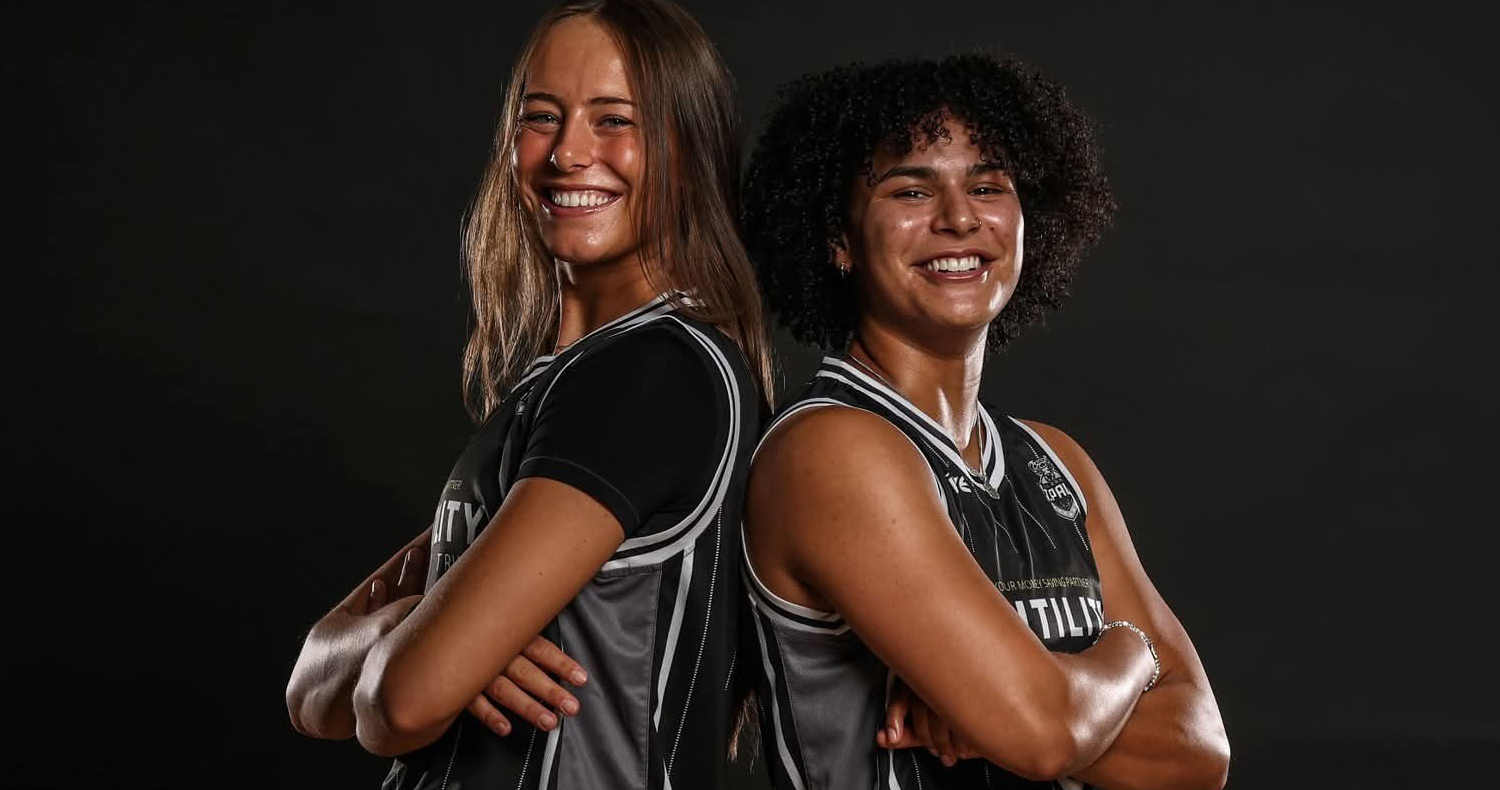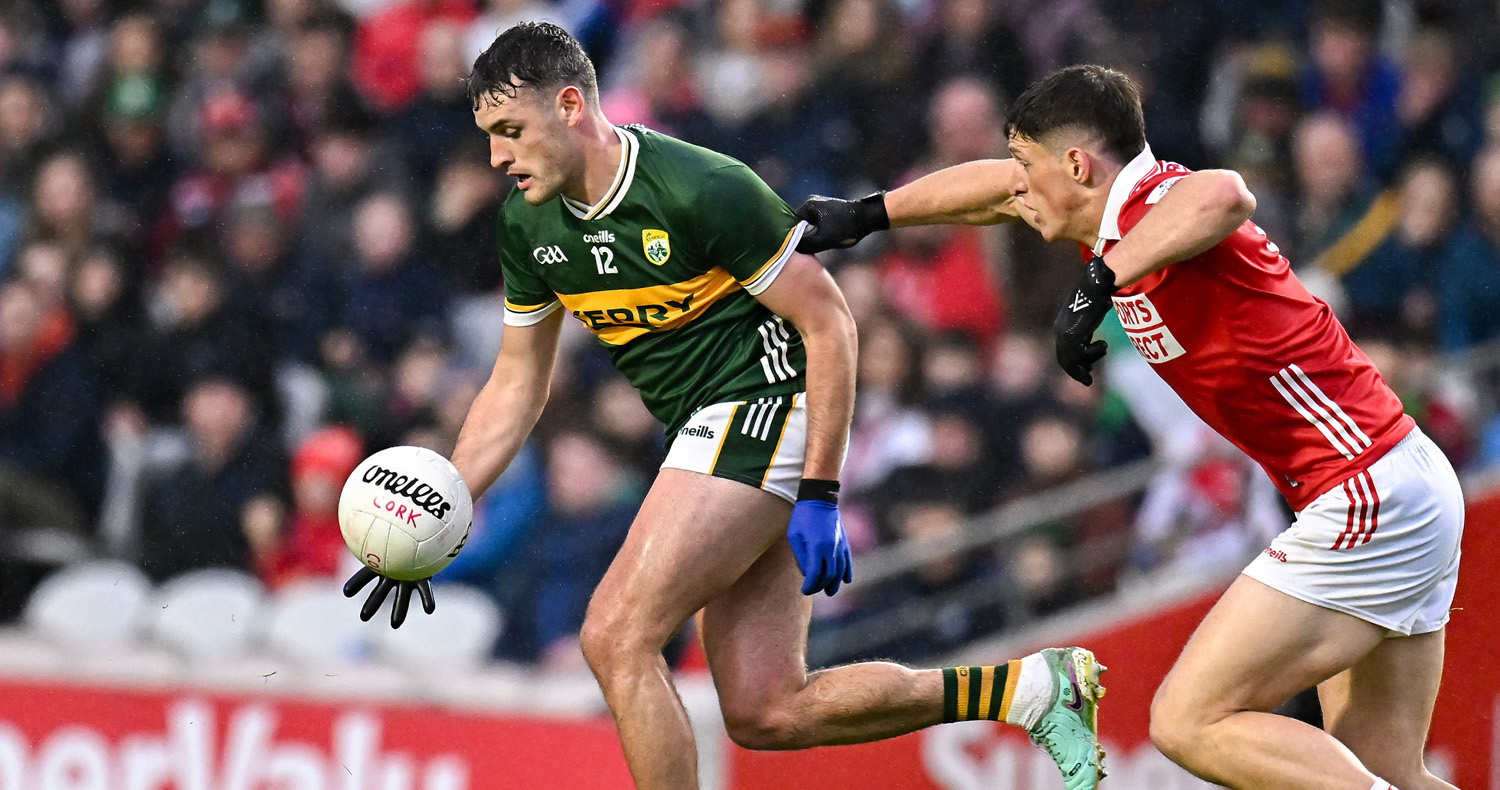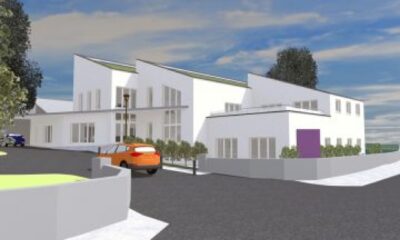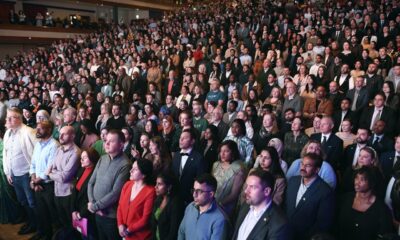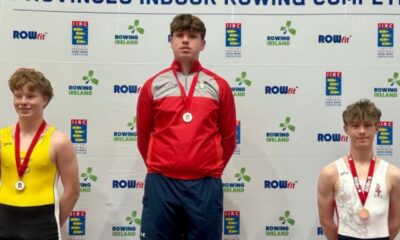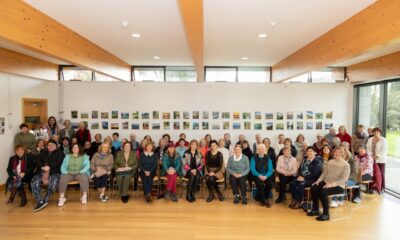Sport
Birdie after birdie: The remarkable golf career of Michael Guerin

Legendary Killarney golfer and three-time South of Ireland champion Michael Guerin speaks to Eamonn Fitzgerald about some of his career highlights, including a remarkable round which included 12 birdies in 13 holes
Recently, I was playing our friendly fourball in Killarney and got to the compulsory stop off at the 9th on the Mahony’s course to sample the tea and hot scones prepared by the genial Paul Cotter in the Chapel. He was waiting with a single lighted candle on a scone. Why?
A fourball came off the 14th on Killeen, regular visitors to Paul’s: Dermot Foley, Seán Brosnan, Tom Prendergast and Michael Guerin, wearing that distinctive white golfer’s cap. He was celebrating his 80th birthday that day and what better way to start the celebration than to play the game that made him famous?
No need to divulge his score after 14 holes, except that it was low, too low for an 80-year-old and leading his direct opponents Foley and Prendergast. Brosnan and Guerin had the bragging rights in this competitive fourball where there are no gimmes. All four are very competent golfers and age has not disempowered the octogenarian, whose smooth, delightful swing grooved in the heat of battle on his eight international caps for Ireland and, of course, in the prestigious South of Ireland Championships. Michael Guerin won this major three years in a row in 1961, 1962 and 1963. More about that outstanding achievement later.
THE YOUNG CADDIE
Michael was born in Aghadoe and then the Guerin family moved to Gortroe. Michael has been there ever since. Living just across the road from the Killarney Golf & Fishing Club, it was only natural that golf would be an attraction. He started off working as a caddie, especially for Dr Billy O’Sullivan, a great sportsman.
“I caddied a lot for Dr Billy and he was a very good player,” Michael recalls. “I picked up many tips from him and started off with just one club, a 4 iron. I learned how to play all kinds of shots with it – it was a difficult enough club to use. Dr Billy encouraged me when he saw I was interested. He must have seen some potential in me.
“I caddied for him in the Irish Open (1953) and there I saw how top-class golfers played the different shots to bring in a low score.” Michael was just 12 years old at the time.
“Billy loved the weekday ball. Thursday was a half day for most employees in Killarney at that time, so it was a very popular day for golf. Many of the priests in St Brendan’s were good golfers and played on Thursday afternoons. Dr Billy’s fourball included John C (Cooper), Scottie (Eamonn Scott) and Tom Cooper (the cinema). Frank Campbell was another regular.”
What was Killarney Golf & Fishing Club like in the early fifties?
“Killarney was very elitist as far back as the founding of the club and that continued. There were very few members, especially lady members, who were wives or spouses of the men.”
That is quite a change to the present membership. “Yes,” Michael agrees, “there is a huge membership now and it isn’t confined to those with status in society. There is a huge number of ladies playing on equal terms as full members with the same rights as the men. That’s the way it should be.”
Caddies were not allowed to join the club as members in the early fifties so, in Michael’s early days, caddying for Billy and co. was all he was allowed to do on the course. All he could do was learn from the Doctor about the game of golf. Both Dr Billy and the great Jimmy Bruen took a great interest in this caddie and he learned so much from them. He was working at Liebherr, as was his brother, Patrick.
“Patrick was a fine golfer, but unfortunately he was killed as a young man in the factory and that was an awful blow for the family.”
Eventually Michael was allowed join the club in August 1959 and was given a starting handicap of - wait for it - 7. Money wasn’t flaithiúil in the Guerin household, so there was no hope of acquiring a branded matching set of clubs fitted to the unique requirements of the then 18-year-old.
He started with a set of ladies’ clubs which included irons 4, 6 and 8. Added to these were 3, 5, 7 and 9 irons from a men’s set, as well as a driver. This unorthodox mismatch of a set also included a Pinpointer pitching wedge and for a putter he used a Crotty blade. That was his arsenal for the first club competition he won, Mrs Grosvenor’s President’s Prize in Mahony’s. That was the only course in the club at the time; the Killeen course didn’t come on stream for another 20 years.
Undeterred by his lack of a matching set of clubs, Michael shot 71 gross, one under par, a 64 nett and that was a v-par competition.
That was a morning competition and a separate competition was played in the afternoon. The young fella was cut three shots for his exploits in the morning competition and had to play off a handicap of 4 in the afternoon fourball. For the first ever Killarney Scratch Cup, he was eternally grateful to the benevolent Scottie who gave him a loan of his clubs, bag and trolley to play. He was also very fortunate to get to know the great Jimmy Bruen, who saw the great potential in the young golfer.
“I used to deliver milk to him,” Michael says. “He had a caravan down near the Hotel Europe and later moved to a spot near the 1st in Killeen. It was into the left as you started on the road linking the present 1st and 3rd.”
Within one year he had worked his game through the seven-shot concession to become a scratch golfer. Impossible, us mortals would contend, but he developed his own game and practiced endlessly. “Yes, I was constantly on the practice ground perfecting the game that suited me best.”
So, he started with a 7 handicap, then to 4 and later to 3 and then to 1. Never at 2. That was some achievement. 7, 4, 3, 1, scratch, +1 and then +2?
“That is correct,” Michael confirms.
Christy O’Connor, the maestro himself, was the pro in Killarney at that time and there was huge excitement when he partnered with the Brad (Harry Bradshaw) to win the Canada Cup in 1958. That is now known as the World Cup. The two Irish heroes were paraded through the town of Killarney when they returned with the coveted trophy.
Michael’s progress as a golfer was on the up and up. Within one year of becoming a member in Killarney he went on a winning streak. In 1960 he set a new course record for Dooks, carding an amazing 63 (five shots better than the existing record).
Not surprisingly, he was called up for the Munster team and played in the inter-provincials in 1960 and in 1961. In a sparkling inter-provincial career he played at Royal Dublin, Royal Portrush, Newcastle, Co. Down, Rosses Point and Lahinch.
BIRDIES AND EAGLES
“I was [a big hitter] in my hey days and regularly my tee shot on the 13th in Mahony’s went down the hill stopping short of the drain. I could also send my drive on the 16th down over the hill on the fairway, stopping short of the drain. That was then and not now. That is the one thing you notice as you grow older, your shots lack distance – even the well struck ones.
“My second shot then to both of those greens was an easy wedge, so I was putting for an eagle and birdie at worst.”
Killarney members who played regularly with him also say Guerin was an excellent putter.
“I was full of confidence in that part of my game. I had practiced over and over again a putting style that suited my game. Then all I had to do was to roll the ball into the cup and to do it consistently. There are very many amateur golfers and even some professionals who have a great round going, but lack consistency on the greens, not sinking those 10-footers. What should be a single putt goes to two and sometimes even to the dreaded three. That inconsistency would wreck any promising round. You must size up the putt, decide and then deliver. I never neglected practising this vital part of my game.”
How many putts would he take on a regular round?
“It was all on the Mahony’s course at that time and we were playing off the championship tees (blues). Killeen wasn’t open until 1971. On average I took less than 30. I carded a total of 23/24 putts regularly and my best ever was 21. Those 21 putts came in the Racing Cup, a very popular competition at that time held in conjunction with the July Killarney Races meeting.
“I shot 64 and that included just 21 putts. Danielo (Connell) was a very good putter, but he said it couldn’t be done. He didn’t believe I took just 21 putts in the round for the Racing Cup.
“I went around quite regularly in the 60s for the par 72 course in Mahony’s, off the blues all the time. I shot several 60s and it all came together on the day I returned a 66 gross, a course record.”
What is his secret to bring in such low scores on a regular basis?
“A good tee shot is a great start and sensible decisions on where you want your ball to land. Many gofers do this consistently, but too often play poor approach shots. These must have be very well judged to get close enough to have a go for the cup with a single stroke. A single putt can make up for bad shots out the course and allow you to finish with a good score overall.
“So many players who are fine strikers of the ball, have all the right type of shots to manage the challenges of the course but leave shots go on the approach to the green. Your shot must be accurate, allowing for the contours of the green. Give yourself the chance of a single putt. Again, I emphasise the importance of practice, but practice with a purpose. Spending hours on the putting green and stroking countless balls is of little value. It is not the number of putts you take in your practice that counts when you want to transfer that learning lesson on to your round. Make less putts when you are practicing, but make planned putts. The only putt that matters is the one I am taking now.”
Can Michael recall any really exceptional round?
“I certainly can and doesn’t every golfer remember the day he/she shot an exceptional round. Mine was in a competition playing against Ivo (Sullivan). It was a 13-hole competition in Mahony’s old course, where I carded 12 under for the 13 holes off the championship tees. It was birdie after birdie.”
PRIZE
Michael Guerin caddied for Dr Billy O’Sullivan in the 1953 Irish Open Golf Championship played in Killarney, where Norman Drew beat the local Doc in the final. Remember, caddies were not allowed to become members of the Killarney club, to preserve the elitism so prized by the members at that time. That was the way until Michael Guerin was eventually accepted as a member in August 1959.
Playing off a handicap of 7, the 18-year-old won his first prize, the President’s Prize, in September 1959. He progressed quickly and entered for the O’Sullivan Cup at Dooks on the August Bank Holiday 1960, creating a new course record by bringing in a magnificent 63. This was five shots better than the previous record.
That was some score and no one believed that an unknown and unrated golfer would reach the heights in the Irish Close Championships at Baltray. The course record of 70 was held jointly by Christy O’Connor, Eric Brown and Joe Carr. Guerin sparkled, returning a 70 and leading the 32 qualifiers on 141 (71 & 70).
“Yes, a massive 70”, Michael recalls. It included birdies at 7 and 8 and a dyke (birdie) at the 16th. His unbelievable second shot stopped three feet short of the hole. “I three-putted the famous short 18th.”
His only comment to the press was, “I would have liked a 69”. His nearest rival Billy Malone was five shots adrift. Another Killarney sportsman, the late John C Cooper, was also well in contention with 152 (71 & 77).
FIRST SOUTH OF IRELAND
In 1961 he travelled to Lahinch for the South of Ireland (SOI). Michael Guerin was an unknown among the top amateurs in Ireland, and he astounded the field by winning it. He defeated the judge, the highly rated Ian Bamford, with an emphatic 7 and 6 win in the final. Conditions were wild and wet.
What’s more, he continued his great form and completed an historic three-in-a-row in 1962. It was very hard for Guerin to even get to the Clare venue as the journey involved a four-hour bus trip with (hopefully) four days of competition. The format at that time was all matchplay with the final of a Wednesday over 36 holes. “You were really on your own,” he says.
Lahinch is a very testing links course and the prestigious SOI was the most coveted prize on offer, attracting the top amateurs in Ireland. It was tough to survive over the four-day competition. It was first played for in 1895 and has continued ever since apart from the war years and during COVID. Some of the top Irish professional golfers of recent decades earned their spurs by winning the SOI. Winners as amateurs at Lahinch included Darren Clarke (1990), Paul McGinley (1991), Graham McDowell (2000) and James Sugrue (2017). Strangely enough, Pádraig Harrington never won the title. The closest he came to victory were finals he lost to David Higgins (Waterville) in 1994 and by Jody Flanagan in 1995.
One other winner (amateur) of the SOI was Mick Morris, centre back on Kerry’s All-Ireland winning teams of 1969 and 1970. He was also subsequently capped for Ireland.
THREE-IN-A-ROW
In 1961, the 28-year-old Ian Bamford of the Royal Portrush was the pre-tournament favourite and he showed why as he worked his way to the final. He was a senior Irish international in 1954 and was unable to play for Ireland on some subsequent years as he had moved to Canada. The big surprise was 20-year-old Michael Guerin, who had been a member of Killarney club for just two years.
His opening hole yielded a birdie but then it was up and down for long periods. The young fellow from Killarney would surely crack, but he battled back on several games. He had a mighty battle before seeing off Fitzgibbon 2 and 1 to qualify for the final.
The vastly experienced Bamford was the firm favourite to win the 36-hole final, but Guerin defied the odds. He claimed his first South of Ireland in 1961 by winning 7 and 6.
He was still basking in glory when he received a treasured letter on August 21 confirming the he had been selected for the Irish team internationals at Portmarnock. The letter was addressed to Michael Guerin, Crane Factory, Killarney.
“What I enjoyed most about winning my first SOI in 1961 was coming home to the clubhouse in Killarney with the big cup and seeing so many club members so happy to have the cup in the clubhouse for the first time. We celebrated over cups of tea. Mrs Grosvenor was a proud woman and there was a great sense of satisfaction that all the time I practiced here had paid off.”
Guerin was the youngest person to win the SOI and also the first Kerryman to lift the coveted trophy His supporters at the SOI included Patie O’Shea, Paddy Vaughan, Brian Mulcahy, Kevin O’Dea, Cally McCarthy, Peter Malone, Derry O’Donnell and Scottie. “They kept following me around and that helped.”
In 1962, the Gortroe man was defending his title and standing in his path was David Sheehan (UCD), a fellow Irish International and Walker Cup player. Both he and Guerin worked their ways through to the final; it was the duel that everyone wanted to see. Guerin won the greatest match of his career to that point, defeating Sheahan 2 and 1. It was sweet revenge for him having lost by 2 and 1 the last time they met in the Irish Close at Rosses Point three years previously.
In 1963, he beat Lahinch's Michael “Darkie” Skerritt 4 and 3 to complete the magnificent three-in-a-row and the press ran the headlines, ‘Michael Guerin: King of Lahinch’.
“When I get under pressure I play well. I love the cut and thrust of competition.”
When he returned to the SOI much later in 1979, the 38-year-old Guerin had to fight hard to survive. He was four down after eight versus John McHenry, the well-known golf pundit on RTÉ. He levelled on the 18th and won it on the 5th tie hole. Guerin drilled his trusted 4 iron shot to within four feet of the hole and eagled for a win. Typical fighting spirit once more.
“I was well on my way to exit the competition at the quarter final stage when DD O’Connell left the Killarney supporters in disgust and headed for the clubhouse saying, ‘my dear men, Michael is out playing the Klondike (5th hole) at the moment and…’ When we got back to the clubhouse, DD couldn’t believe I had won the match with a strong finish.”
Guerin kept driving on and was narrowly beaten by Vincent Nevin in the final.
He met the Irish international Brian Malone on three occasions and won them all, coming back from five down with six holes left to win on the 18th in the junior internationals at Rosses Point. In the semi-final, he won on the 20th hole.
BANDAGED THUMB
He played inter-pro with Munster on 30 occasions and won eight Irish caps. Indeed, on one occasion he cut his left thumb on a grinder at work with Liebherr and even though it was red raw and very painful he played with a heavily bandaged left thumb in the junior internationals. He was off work for several months with that injury.
Michael was rated “the longest hitter”. His last appearance for Ireland was in 1963, before he turned professional.
He won several Scratch Cups, such as Killarney (twice), Cork (three times), Kenmare, Tralee, Thurles, Macroom and was runner-up in other Scratch Cups at Waterford, Killarney, Tullamore, and Cork. He never won the Irish Amateur Close. His closest was in a final when he lost to Philip Walton, Malahide, who went on to have a successful professional career.
Guerin also went professional for a short few years. What was that like?
“Pro life was very different then than it is at present,” he explains. “Jimmy Bruen and Dr Billy encouraged me to go professional on foot of my great career as an amateur. There was no sponsorship or other help available when I joined the ranks, but I was very grateful to the Mulcahy family who provided me with shoes etc. (Marguerite Mulcahy is the current President of the Killarney club.)
“It was a tough decision, but I decided to have a go. I joined the exclusive Temple club of less than 100 members near London as assistant-professional to the very well-known Henry Cotton. The harsh reality was brought home to me very quickly. I was paid £3 a week and of that I had to pay £1/10 (one pound, ten shillings) a week for my bed and breakfast at the club. I was giving lessons for £3/10 (three pounds, ten shillings) and the same fee for playing with members, and then had to give 50% of that fee to Henry Cotton. That wasn’t very attractive. My mother died suddenly and I came home for her funeral. When I returned to England, I went to the Flackwell Heath club as assistant-pro, where the wage jumped to £10 a week, but no accommodation provided.
“I suppose the professional Jeyes tournament played in Killarney (and televised) was my highlight as a pro. I was going well on the final day despite the dreadful storm and rain. Peter Allis (TV golf commentator) and Dave Thomas were joint leaders, but I was climbing up the leaderboard. I was playing the 15th when rain stopped play and that became very controversial. My partner, Jimmy Kinsella, agreed to play on and I finished off for a record 66. It was not recognised by the tournament directors, but the Killarney club recognised it.”
It was a remarkable score on dreadful competitions and readers may view the scorecard on display in the clubhouse. That record 66 still stands. He won 6 pro-ams before leaving the professional ranks.
SEVEN-YEAR WAIT
“I decided to give up my professional career and then it took me seven years battling with the R&A to regain my amateur status. I really missed the freedom to play regularly during that time. The highlight of my return as an amateur was winning the Barton Shield with Killarney at Lahinch in 1980. We should also have won it on the previous year.”
That was the only time that Killarney won the Barton Shield, a poor record for such a big club. The winning Killarney team, managed by Derry Pyne, was Michael Guerin (captain) Seán Coyne, James Loughnane and Brian Mulcahy.
“I really enjoyed playing Senior Cup with Killarney on several occasions. I played with members such as James Loughnane, Seán Coyne and Arthur Spring. Then a great crop of young, low handicappers made it to the Killarney Senior Cup team such as Eoghan O’Connell, Paul Murphy, Kevin Leacy and the Sugrue brothers. Dan went on to play for Munster.”
Guerin continued to play for Munster and beat Des Smith, who went on to have a lucrative professional career.
MAHONY'S V KILLEEN
I spoke to Michael about the difference in playing Mahony’s in contrast with playing Killeen. “Both are great courses,” he states. “Mahony’s off the blues offers plenty challenges. I played most of my golf there in the old course, before Killeen was opened.”
The 18th rates in the top 100 in the world. How does it get such a high rating?
“The 18th is a great finishing hole and many a fine card has been ruined on this hole. It is not extra-long for a par 3, but the drive is very tight into a narrow green, which is so difficult to reach unless you drill it straight. Pull it to the left and you may never find it and if you do you will most likely have to take a penalty shot. Any hint of a slice and the lake gobbles it up, more so in winter when the lake is fully in. It’s a great test and the scenery is magical.
“Killeen is a tough challenge for players of all handicaps and not just because it is about 500 yards longer than Mahony’s. (Off the blues, Mahony’s is 6,164 metres while Killeen is 6,583.) But Killeen rewards accuracy, precision and good course management.
“Take the first four holes, all demanding accurate tee shots. Your first shot of the day is always a challenge. In Killeen, any hint of a slice sends you down the shore and then it is a case of damage limitation. Too far right and you are playing too low an iron to a tight enough green that has the flag stick out lakeside, inviting an over-hit shot to drop into the lake. In my younger days, my tee shot went out over the bunkers, over the road and I had a much safer second shot to hold the green. I don’t drive it that far anymore.
“On the 2nd it is trouble all the way up the right-hand side. The par 3 third demands good club choice and you cannot quit on the shot otherwise the encroaching lake will call for a new ball. Going through the green leaves you with a difficult shot back and the only bail-out is a small enough section on your left. Know your driving distance for the 4th. Hit it too well down the middle and the ball can hit the ridges on the narrow part of the fairway and dart to the right and into the lake, especially on the hard summer fairway. Too far left and the trees are on your way. The driver may not be the best option for this tee shot.
“So, my advice for the first four holes in particular is to play strategically, safer and shorter. Keep the ball in play. In stroke any uncontrolled play will mount up those shots so early in your round.
“Other holes in Killeen present their own challenges. Sensible strategic play is the key to bringing in a good score in Killeen. Think your way around the course and be just as careful with the putts, avoiding three putting. Killeen is a great test for all players, irrespective of handicap. And the scenery is magnificent.”
KEVIN O’DEA
I spoke to Kevin O’Dea earlier this week. The former St Anne’s Road man, now domiciled in Greystones, won the Killarney Senior Club Championship on two occasions, one off a handicap of 3 and later, much later, playing off 23.
“I have many happy memories playing with Michael Guerin and supporting him on tournaments such as the South of Ireland. That three-in-a-row was very special. Michael had all the shots, executing whatever one was needed. I saw him play an impossible recovery shot from the shore in Lahinch and get down in regulation when a multi-bogey seemed to be the outcome. He had all the shots.
“We often played a fourball and when it came to the 18th in Mahony’s, we elected to tee off from the edge of the present 17th green. Even that didn’t faze him. Invariably his tee shot was on the green even in winter conditions and winds rolling off the lake. He had the shot for all seasons and all challenges. Michael Guerin was a pure natural.”
For a man that played so much golf at the highest level, there were surely disappointments along the way?
“My greatest regret was all of seven years I lost in that awfully slow process getting back my amateur status. Since I returned as an amateur in 1972 and playing then off scratch, I have enjoyed my golf immensely. You are still competing against the course and deciding which club will take you to six or eight feet from the pin, another birdie chance, a par at worst. I still enjoy hitting shots in practice and the weekly 4 ball with my friends.
“I am enjoying life and golf,” concluded the sprightly 80-year-old golfer.




